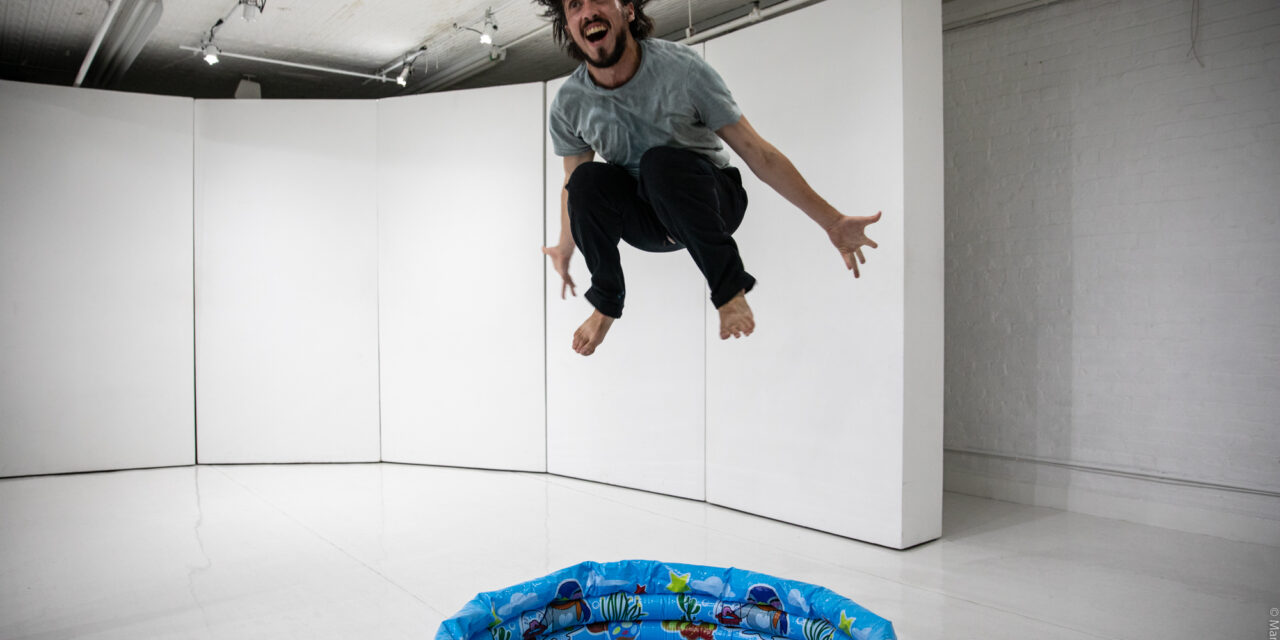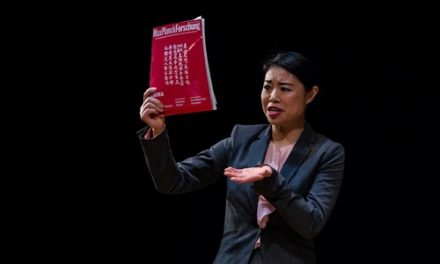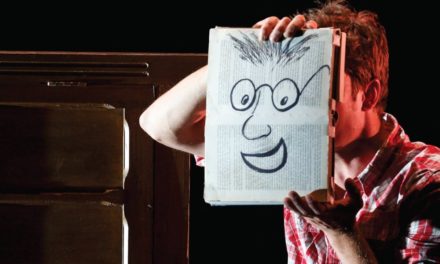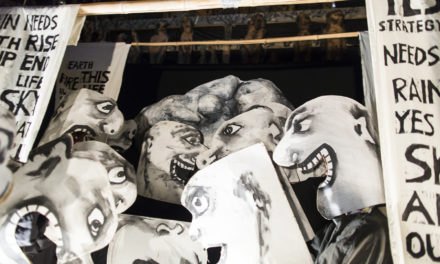True to the group’s moniker, This is Not A Theatre Company’s shows are deliberately anti-theatrical in their execution: often staged in unorthodox places (living rooms, restaurants, swimming pools) and toeing the line between performance and participatory experience, the company’s work strips down theatrical convention to reveal the innate artistry of our lives. Running in repertory at New York’s TheatreLab, TiNATC’s latest productions Play! and Theatre in The Dark: Carpe Diem carry on this practice, both pieces engaging our senses to highlight that which we may trivialize or overlook.
Developed by Ezra Brain, Erin Mee, Charles Mee, and creator/performer Jonathan Matthews, the dance-theatre piece Play! explores our complex relationship to fun and play. Nimbly twirling through TheatreLab’s white-box space, Matthews extolls the collective and individual virtues of play: in its links to socialization, brain development, resilience, and emotional health, Matthews reveals the act of purposeless play to be fundamental to our humanity. Yet, there’s an ironic seriousness to the “play” Matthews illustrates: he performs yoga stretches as a Siri-like voiceover lectures him on focus and intention, cavorts in a kiddie pool while describing the link between play and productivity, and uses gestures of balance, flexibility, and freedom to embody the traits of an ideal society. This dichotomy reaches its fullest expression in a sequence where Matthews recites litanies of BuzzFeed self-improvement articles while tangling himself in the white streamers adorning an onstage column. Becoming increasingly trapped as he tries to leverage himself with ribbons and advice, a frustrated Matthews concludes the quest for self-improvement to be merely “capitalist marketing of the Puritan work ethic disguised in a neo-liberal framework”—that is to say, stripped of the joy it espouses.
However, it is the show’s climax, in which Matthews invites audience members onstage to dance and play with him, that illustrates Play!’s point more clearly than any data or statistic. As we join Matthews in tossing beach balls, blowing bubbles, and dancing around the festooned column, we see that the real benefit of play lies in the doing: in our efforts to capitalize fun, we deprive ourselves of it, but the simple act of group play returns us to our natural state of openness, creativity, and unity. Play!’s message is poignant without being preachy, a reminder to embrace our contradictions without taking them too seriously.
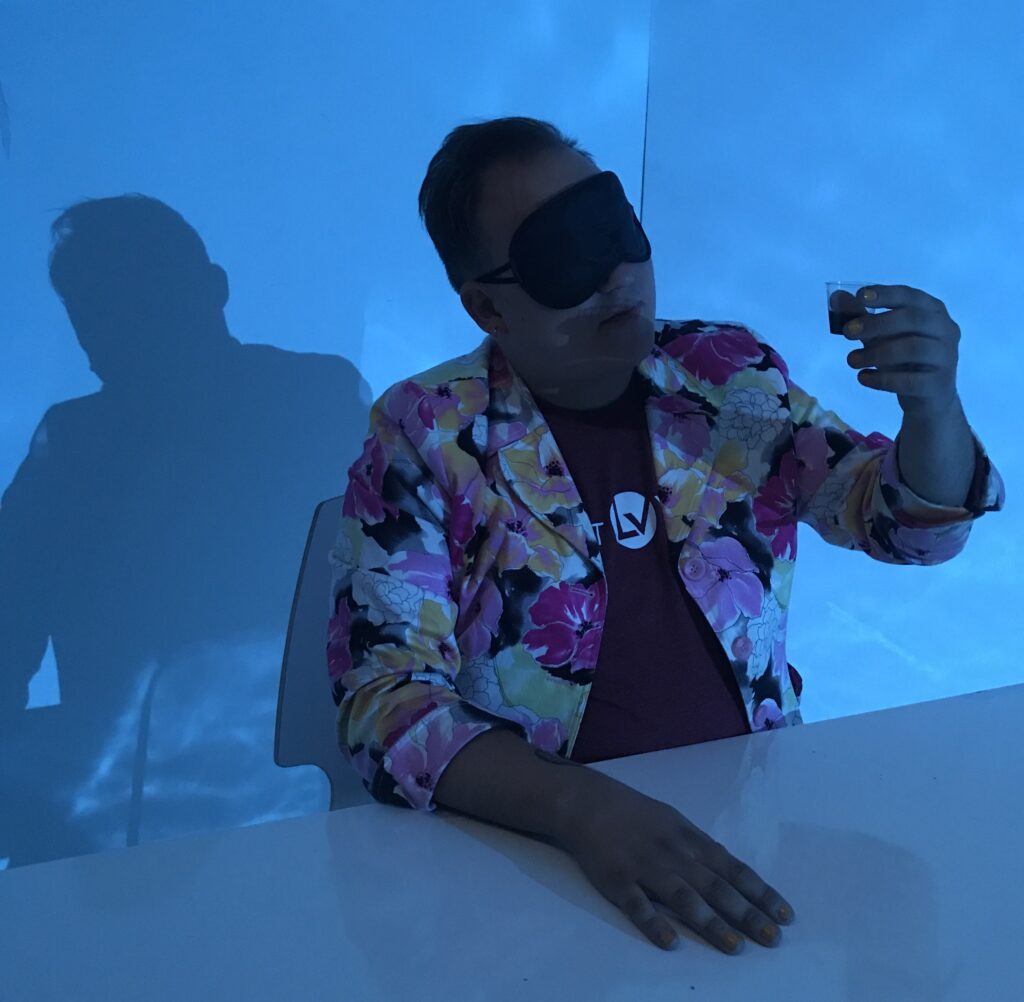
Ezra Theatre in Theatre in The Dark by This is Not A Theatre Company. Photo by Erin Mee.
Theatre in The Dark: Carpe Diem similarly uses direct experience to guide our awareness, in this case heightening our inner and outer perceptions by disrupting our sense of sight. Before the show begins, each audience member receives an eye mask; once blindfolded, we are led into the dim-lit theatre by TiNATC company members and guided to sit at small tables. Though this entry into the show requires a brief suspension of trust, what follows is more meditative than scary: audiences remain seated for the length of the performance, and the ensemble curates the experience gently enough to balance any disorientation.
Theater in The Dark’s facilitators (Caiti Lattimer, Jonathan Matthews, Nicole Orabona, Amanda Thickpenny, Charles Mee, Ezra Brain, and Marisa LaRuffa) treat us to a multi-sensory experience, each “act” of the performance an array of expertly-paired sound, scent, touch, and taste combinations. Actors spritz rose water and serve us Turkish Delight as a recording of Robert Herrick’s poem advises us to “gather ye rosebuds while ye may.” Wave sounds, fan breezes, and grassy scents enfold us in the landscapes they evoke; the “dance” of a chocolate truffle on our tongues reveals the sharp spike of ginger within. Frequent allusions to time (sounds of ticking clocks; meditative T.S. Eliot poems; the detritus of orange peels and empty cups) prompt further attentiveness, highlighting the ephemerality of all we perceive. One’s own mind also shapes the journey, the absence of visuals allowing us to go within and witness our personal responses to, and associations with, the piece’s elements. Likewise, individual tendencies to analyze what we encounter, guess what comes next, or simply absorb the experience can give the piece a different trajectory for each participant. Even the final removal of our eye masks becomes part of the show, as we compare our experiences and confirm our perceptions (yes, that was a sage leaf). Fortunately, TiNATC encourages this casual reorientation, giving us ample time to linger and bond with fellow participants.
Distinctly unorthodox but disarmingly accessible, Play! and Theatre in the Dark: Carpe Diem celebrate our capacity for joy, mindfulness, and connection. By prompting us to slow down and steep ourselves in moments of pleasure or fun, the company makes a stronger case for the benefits of such practices than any lecture or listsicle could. Though achieving balance in this world can, ironically, be stressful, TiNATC’s work reminds us to greet this paradox with a healthy sense of play.
This post was written by the author in their personal capacity.The opinions expressed in this article are the author’s own and do not reflect the view of The Theatre Times, their staff or collaborators.
This post was written by Emily Cordes.
The views expressed here belong to the author and do not necessarily reflect our views and opinions.

